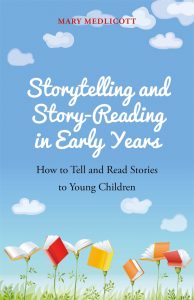A contract to write a book offers a fantastic opportunity to consider your thoughts. Storytelling and Story-Reading in Early Years was a challenge. It meant thinking back over 30 years of very varied experience as a professional storyteller, working with every age-group and in all kinds of venues in the UK and overseas. What could I crystallise about working with young children? The question meant far more than thinking about the immediate experience of a storytelling session – what stories to tell, how to gain and keep the children’s attention, how to manage the occasional difficult child. It also meant reviewing my regular practice in terms of arranging a session – where to get children to sit, how long the stories should last and how to relate to the members of staff who regularly worked with the children and also, maybe, to the parents who might later hear bits and bobs about what we’d done.
There was another issue too. Storytelling of the oral sort was to be only one side of this book. Story-reading was also to be considered. For this side of things, I found myself thinking back to the early 1980s and my four years of part-time work for the now-defunct Lambeth Library Storytelling Scheme. After all, this is what had got me into storytelling in the first place. It had been an important experience. Throughout the four years, I’d kept careful notes and on reflection there were so many ways in which it had taught me my trade not only with Early Years children but audiences in general. As I reflected on it, I also began to see the many common features between story-reading and storytelling and how one can lead to the other. This proved a helpful realisation.
Over the years as a professional storyteller, I’ve run innumerable training courses for Early Years staff and for parents. These have meant taking on board the fears and worries so many adults harbour about themselves. Fears of speaking up in front of children when other adults are nearby. Fears of things getting out of control and resulting in chaos. Worries people have about their voice: is it too soft, too deep, too boring? Plus for people from other cultures, there’s frequently a worry about whether their English is good enough. As well as all this, the idea of telling a story without a book is something completely unfamiliar to many today. Some are terrified of the prospect until they dare to try it and see what power it has.
Soon I realised that my varied experience across the years had taught me enough to write about the Early Years side of my work. Next came the actual writing. Type of language, style of presentation, numbers of chapters: all these became issues to resolve. Also it’s normal for me that my head is full of little anecdotes from my working life. Would I be able to include a selection from the Early Years work in such a way as to draw attention to them? I’m so happy this proved possible. For me, anecdotes capture so much about the realities of what goes on.
Surrounding the personal issues outlined above, there was also a strong awareness of how vital it is today to encourage the direct telling and reading of stories to children. Nowadays even very young children are spending considerable amounts of time with their devices. On screen are many stories in the form of games and cartoons. Yet the age-old experience of human beings all over the world is that the stories heard directly from parents and others when they’re young constitute some of their most formative experiences. It’s not just the stories. It’s how they are given and the bonds that are strengthened in the process.
Such concerns gave me a wider purpose in writing Storytelling and Story-Reading in Early Years. In my own childhood growing up in Wales, my father was one of my most important storytellers. There were others. I was lucky. Aware of my own good fortune and what importance so many other people attach to such experience, I feel it can now be a mission of mine to add to the growing awareness of the loss our society will suffer if children today fail to get it. A recent survey from Nielsen Book Research established that there has been a significant fall (almost a fifth since 2013) in the numbers of parents regularly reading to children. Parents are apparently too busy and too tired to make time for it. I’d like to help persuade them otherwise and meantime, too, to ensure that young children also receive the best possible experience of hearing stories at nursery or school. – Mary Medlicott
In this easy-to-read and essential guide, storytelling trainer Mary Medlicott gives professionals the tools to get the best out of oral storytelling and story-reading sessions, with management, performance and language techniques.
Included are examples of stories and post-story activities that are most successful with children of ages 2 to 5. Medlicott shows how to prepare for the session, spark children’s imagination with props, voices and facial expressions, and encourage empathy with thoughtful use of language and variety.
If you would like to read more articles like this and get the latest news and offers on our early years books, why not join our mailing list? We can send information by email or post as you prefer. You may also be interested in liking our Special Ed, PSHE and Early Years Resources Facebook page.

